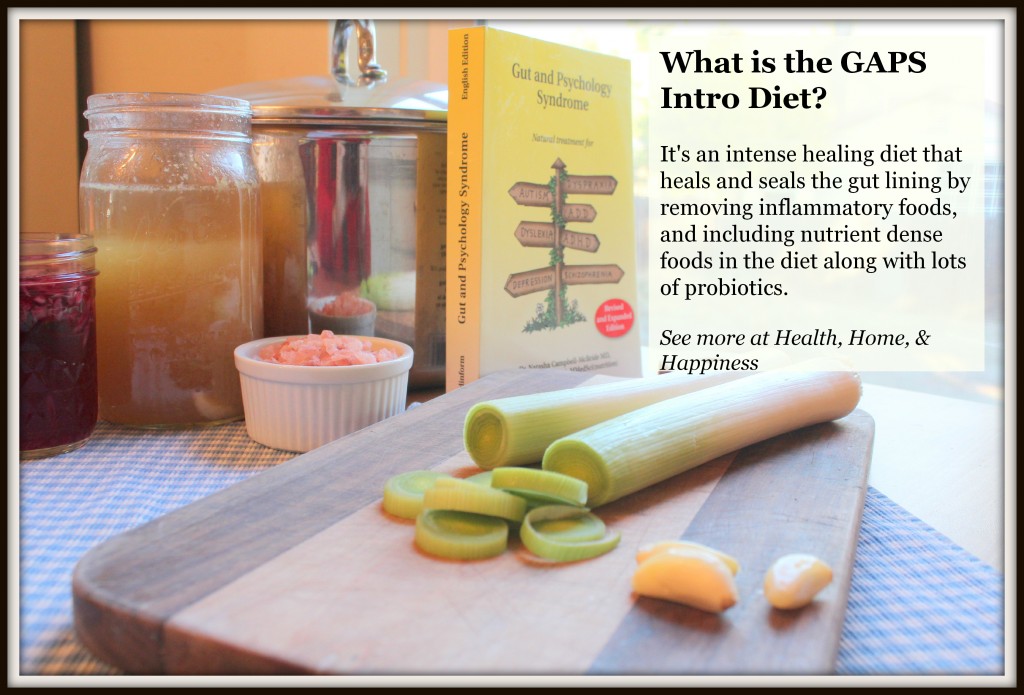
What the GAPS Intro diet is
The Gut and Psychology Syndrome introduction diet is a diet focused on intensive rest and healing for the gut lining, as well as slow introduction of fermented foods to repopulate it with friendly microorganisms.
See: Recipes for the GAPS Intro Diet
Different ways to use the GAPS Intro
Some, as we did, start the ‘intro diet’ right as we are starting GAPS, others go on ‘full GAPS’ for a while and then go down to the introduction diet. If you are overwhelmed, this may be the better choice as doing full GAPS will help you see improvements without being so restrictive.
Now, after my daughter has been on GAPS for a year, I wanted to put all three of us on the intro diet for a month before we went into warmer weather. Re-going on the intro diet after being on GAPS for a while can give you increased healing and can help get rid of any health symptoms that you didn’t get rid of the first time around.
As a baby, my son had eczema, but when we went on GAPS intro when he was 11 months, it wasn’t seen again until this winter (over a year later) when it’s starting a tiny bit again. So I’m curious to see if running through the intro diet can get rid of those symptoms.
It’s not that eczema is a serious condition, but I know that it’s a symptoms of some underlying imbalance in his little body, and I’d like to do what I can to correct it.
Most of you know that we primarily are doing the GAPS diet for my little girl with autism, and we have seen great results with her on it so far- but we’re always wanting more healing for her, so I hope she can make leaps of progress as well with this repeat intro portion of the diet.
To Heal Allergies
I also would like my children to be less sensitive to diary- my son sleeps better when he’s off dairy, and my daughtergets ‘allergic shiners’ (dark undereyes) which are a symptom of a dairy allergy (yes, even with raw, even with cultured, even with goat! Though we haven’t been able to find raw goat milk to try yet, but we did tryculturing goat milk from the store) The last time we went through the introduction portion of the diet I was able to heal my dairy allergy in just a few weeks- which has been great!
Meal Plans
I have a 30-day meal plan for the Intro Diet, and for that I summarized from the GAPS book what is allowed on each stage, which I’ll share below. I would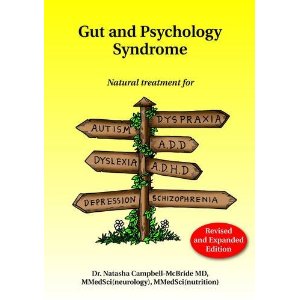 not try to do the intro diet without first reading the GAPS book and understanding the philosophy of the diet, I know the book is expensive, but it costs less than even one doctor’s visit :) You can purchase the GAPS book here.
not try to do the intro diet without first reading the GAPS book and understanding the philosophy of the diet, I know the book is expensive, but it costs less than even one doctor’s visit :) You can purchase the GAPS book here.
- Learn more about the GAPS Intro Meal Plan Here- called What Do I Eat Now?
GAPS Diet Intro Stages
You can eat on stage 1:
• Meat or fish stock
• Well boiled broccoli, cauliflower, carrots, onions, leeks
• Squash, winter and summer
• Boiled meat
• Sea salt,
• 1-2 teaspoons a day of sauerkraut juice
Stage 2
You can eat on Stage 2:
• Meat or fish stock
• Well boiled GAPS-legal vegetables (no starchy root vegetables)
• Squash, winter and summer
• Boiled meat
• Sea salt
• Fresh herbs
• Fermented vegetables; sauerkraut, kimchi, pickles
• Fermented fish
• Egg yolk, organic, carefully separated from the white
• Homemade ghee
• Stews and casseroles made with meat and vegetables
Stage 3
You can eat on Stage 3:
• Meat or fish stock
• Well boiled GAPS-legal vegetables (no starchy root vegetables)
• Squash, winter and summer
• Boiled meat
• Sea salt
• Fresh herbs
• Fermented vegetables; saurkraut, kimchi, pickles
• Fermented fish
• Egg yolk, organic, carefully separated from the white
• Homemade ghee
• Stews and casseroles made with meat and vegetables
• Ripe avocado mashed into soups, starting with 1-3 teaspoons a day
• Pancakes made with nutbutter, squash, and eggs- fried in fat or ghee, start with one a day
• Scrambled eggs made with ghee and served with avocado if tolerated and cooked vegetables.
Stage 4
You can eat on Stage 4:
• Meat or fish stock
• Well boiled GAPS-legal vegetables (no starchy root vegetables)
• Squash, winter and summer
• Boiled, roasted, or grilled meat (not burned)
• Sea salt
• Fresh herbs
• Cold pressed olive oil
• Fermented vegetables; saurkraut, kimchi, pickles
• Fermented fish
• Egg yolk, organic, carefully separated from the white
• Homemade ghee
• Stews and casseroles made with meat and vegetables
• Ripe avocado mashed into soups, starting with 1-3 teaspoons a day
• Pancakes made with nutbutter, squash, and eggs- fried in fat or ghee, start with one a day
• Scrambled eggs made with ghee and served with avocado if tolerated and cooked vegetables.
• Freshly pressed juices, start with a few tablespoons of carrot juice
• Bread made with nut flour, eggs, squash, tolerated fat, salt
You can eat on Stage 5:
• Meat or fish stock
• Raw legal vegetables, peeled
• Squash, winter and summer
• Peeled, cooked apple, pureed
• Honey, up to a couple tablespoons a day
• Boiled, roasted, or grilled meat (not burned)
• Sea salt
• Fresh herbs
• Cold pressed olive oil
• Fermented vegetables; saurkraut, kimchi, pickles
• Fermented fish
• Egg yolk, organic, carefully separated from the white
• Homemade ghee
• Stews and casseroles made with meat and vegetables
• Ripe avocado mashed into soups, starting with 1-3 teaspoons a day
• Pancakes made with nutbutter, squash, and eggs- fried in fat or ghee, start with one a day
• Scrambled eggs made with ghee and served with avocado if tolerated and cooked vegetables.
• Freshly pressed juices, carrot, mint, cabbage, lettuce, apple, pineapple, mango
• Bread made with nut flour, eggs, squash, tolerated fat, salt
Stage 6
You can eat on Stage 6:
• Meat or fish stock
• Raw legal vegetables, peeled
• Squash, winter and summer
• Peeled, raw apple
• Other fruits, raw, introduce slowly
• Honey, up to a couple tablespoons a day
• Boiled, roasted, or grilled meat (not burned)
• Sea salt
• Fresh herbs
• Cold pressed olive oil
• Fermented vegetables; saurkraut, kimchi, pickles
• Fermented fish
• Egg yolk, organic, carefully separated from the white
• Homemade ghee
• Stews and casseroles made with meat and vegetables
• Ripe avocado mashed into soups, starting with 1-3 teaspoons a day
• Pancakes made with nutbutter, squash, and eggs- fried in fat or ghee, start with one a day
• Scrambled eggs made with ghee and served with avocado if tolerated and cooked vegetables.
• Freshly pressed juices, carrot, mint, cabbage, lettuce, apple, pineapple, mango
• Bread made with nut flour, eggs, squash, tolerated fat, salt- use dates and dried fruit to sweeten.
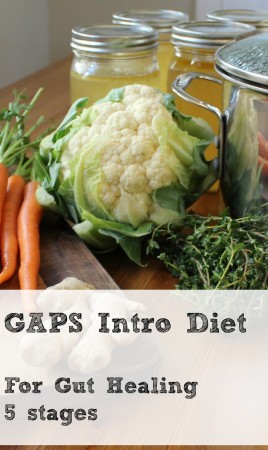
Learn how to heal leaky gut

60-page ebook of all my best GAPS Diet (Gut and Psychology Syndrome) articles all in one place.

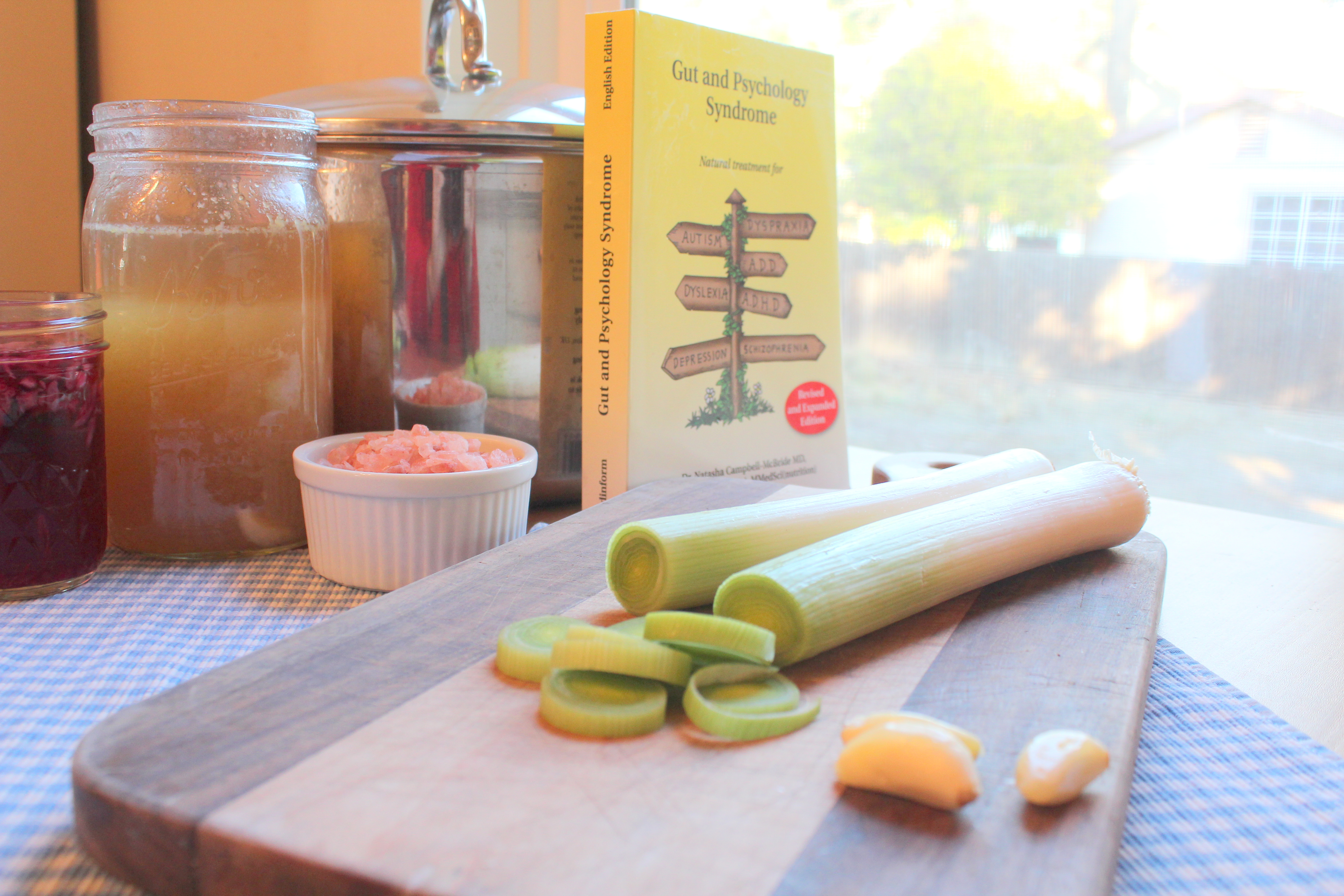
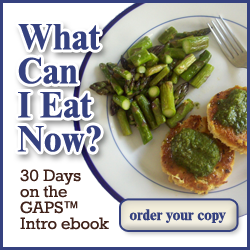
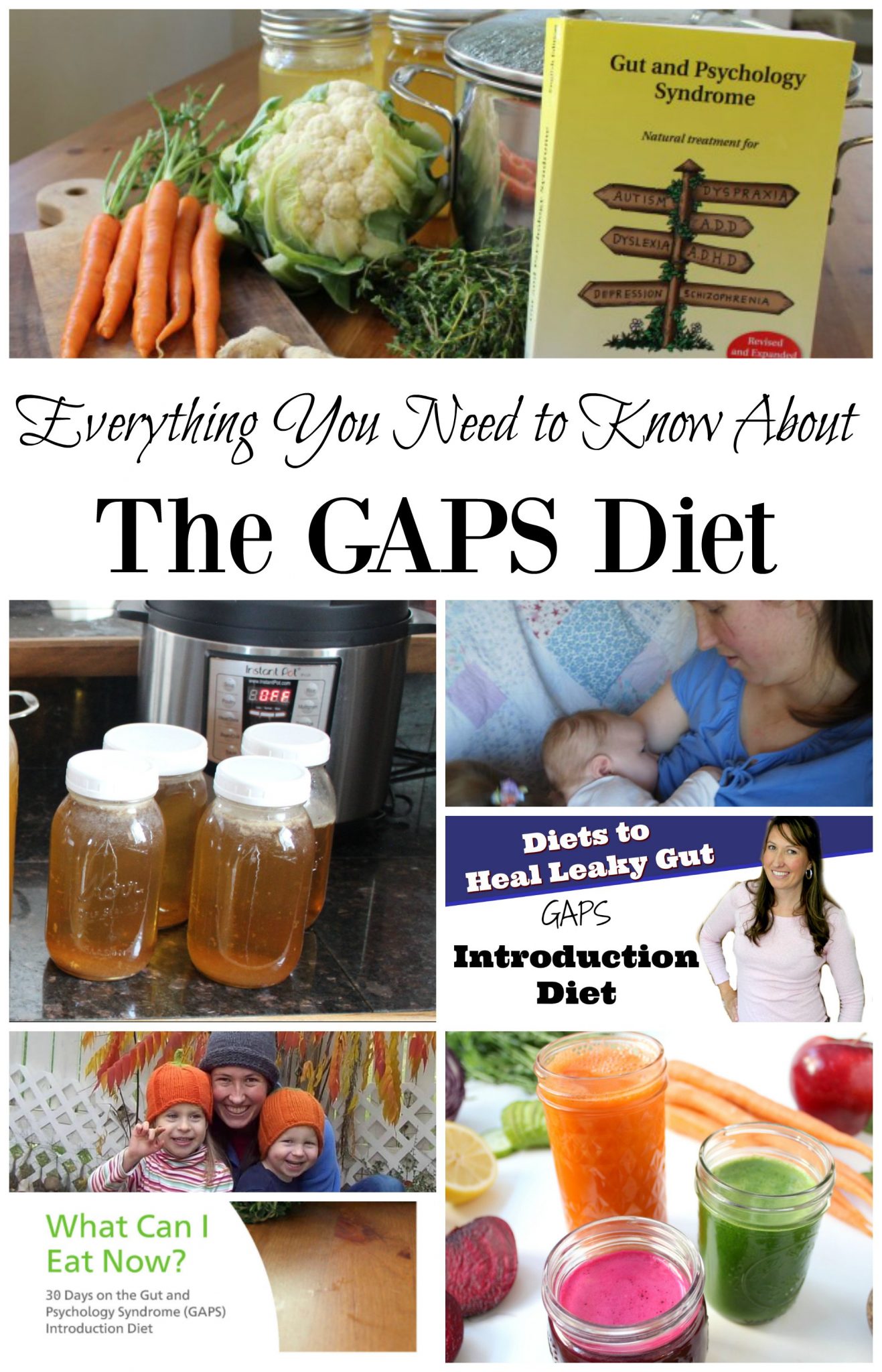
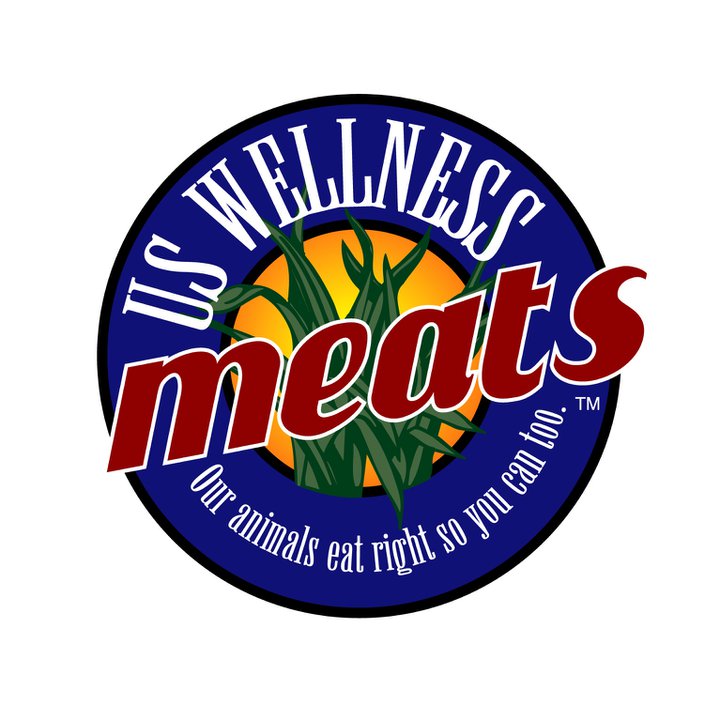



Cara,
Nicely done and very well laid out. One qustions: How do you decide when to move from one stage to the next?
Thansk for you your work.
dia
I think you just try moving on to the next stage, and watch for any bad symptoms (digestive, headaches, etc) when you try new foods.
You’re welcome! :)
It is hard to know if we are having ‘bad symptoms’ or if it’s just the detox effecting us. 2 of my 3 kids have thrown up today on our 3rd day . We all feel pretty icky…can anyone tell me how long it usually takes to get ‘detoxed’? We all feel so fluish and yucky! Praying this part hurries up and goes away! So thankful my family is being supportive…I feel so guilty seeing my kids feel so sick! I know this is really good for all of us, but I’m a little discouraged this afternoon!
Personally, when my kids get sick like that I up the carbs (with a little pureed fruit or fruit juice) and then try going back down the next day. I think it’s usually from going too low carb too quick.
That’s really helpful! We are also seriously considering doing GAPS, I know I really need to for some somewhat minor things. I just want to feel my best. Both my little ones have allergy issues, and I know they can heal…I don’t want those issues to become anything bigger, either. I am waiting to buy the book before we start though, as you mentioned.
Anyway, a side note about culturing goat’s milk…I was just reading about how Meyenberg goat’s milk is ultra pasteurized and therefore not able to be cultured. I think I tried making yogurt out of it before, and it flopped. Did you use a different kind?
I’m not sure- I know you can even make yogurt out of powdered milk, it’s surely not as good as raw, but it still turns to yogurt. :) I’ve used the Meyenberg, and it was more runny than cow milk but I was just under the impression that that is how goat milk yogurt is.
Hey Cara –
We raise our own goats for milk, and I make all our yogurt from the milk. Our yogurt sets up really well. The only time I haven’t had it set up is when I don’t get the milk warm enough. But I second Becky’s comment about Meyenberg – UHT milk doesn’t work. :-) Also, we had a very similar reaction to raw milk in our home as well – only raw goat milk and products made from it work for us. That might be the case for you as well. :-)
Hopefully this summer we’ll have a source of goat’s milk and I can see if I could get good goat yogurt!
Thank you Cara. I just finish reading the stages in the book and was just saying to the book, would you please summarize that for me? And Voila, you did it for all of us! Thanks again!
You’re welcome! I did it for myself too ;) :D
How long do you stay on each stage of the intro diet? Thanks!
I would like to know the answer to this question too! :)
I was always under the impression that dark circles under the eyes meant that the liver was overloaded – maybe from allergies, but not specifically dairy…I’m curious to now where and why you heard they were specifically from dairy. I have them very bad.
That might be what it is- she has an overloaded liver too. But her circles also go away when I pull dairy from her diet, so I think they could come from a few different things.
Cara
Thanks for the post. How do you know if ones liver is over-loaded? My little girl has really dark circles and as an infant she had many allergies and eczema and she has over-grown most of the allergies..but the dark circles are still there.
Any ideas? Thanks again.
Hi Tina, our naturopath actually told me, so I’m not really sure!
I’m fairly certain that dark circles are caused my a casein (milk protein) sensitivity. My family has always been sensitive to dairy for this reason.
This has been an interesting thread. I always had dark circles under my eyes and my chiropractor put me on iron. (he thought I was anemic) That didn’t help.My mom and I just figured that this was just my coloring. I did just notice a few weeks ago, that I haven’t had that problem in a while. Well, I haven’t had dairy for a year and a half! Also, after reading, “What’s eating my Child?”, I believe I have been allergic to milk from birth!
Allergic shiners are often related to dairy consumption. They are a definite sign of allergies of some kind. I get them when I consume any kind of dairy, including raw milk, cheese, yoghurt, and A2 (goats milk). There’s some information about it here: http://fedup.com.au/factsheets/symptom-factsheets/dairy-wheat-gluten-do-i-need-to-avoid#dairy
Thank you so much for simplifying and laying out the intro plan! I just recently bought the books and am hoping to start the intro soon, as soon as we can find a good (and affordable) source of meat and bones for the broth/soup! The GAPS guide is helpful, but your outline makes it much more clear!
Thanks again!
~Charity
Your fermenting veggies look beautiful! I have not tried anything other than yogurt yet. I have never liked saurkraut make with green cabbage. Does the kind with purple cabbage taste different? Is it sweeter? Any recommendations on a good veggie to start with?
You might want to try pickles :) I haven’t noticed a difference between green and red- I just like that the red makes pink kraut :)
Looking forward to the GAPS Menu Planner! Thank you for doing this! I am so ready to start GAPS but have been intimidated by it. This post helped me see it is manageable with some planning! Your planner will be such a great help!
Hi Cara, I just found your site a few days ago and have been scouring it with joy. I have five children and I’m pretty sure they all have allergies, though not all have the same symptoms. We get night terrors, dark circles under the eyes, stomach pain (among other pain) and I just found from the doctor today that my 7-year-old son has extremely high cholesterol. We’re looking at going on the GAPS intro (even my husband is curious now.. yea!), but just like most people, I’m very intimidated. I love your new menu planning help and was curious how soon you thought you might have the intro diet menu ready? We still have a lot of reading to do, so it will still be some time, but I can’t wait to feel better!
Thanks,
Kristi
Hi Kristi, I’m so glad you find this helpful! :) I hope to have the intro menu plan done this month or next.
Hi Kristi,
If you see this, I just wonder if you started the diet and how things are going. We also have 5 children and a very tight budget, which is my reason for hesitation. Mine all have issues, but I’m worried about affording this diet.
Thanks,
Anne
Hi Cara-
I’m about to do GAPS intro for the 3rd time. The two times I did it previously I never stuck really tight to any of the stages, so I’m looking forward to going slowly. I was wondering about stocks on stage 1. I typically make my stocks with some vinegar. Should GAPS intro stocks be vinegar-less in your opinion?
Also, what do you think about roasted vegetables? Could they be included at stage 4 when roasted meat is allowed? Thanks for your sharing your experience! And, thanks for the handy dandy list!
Sarah
Hi Sarah, I’m skipping the ACV as well for intro, just to be safe. I’m not sure about roasted vegetables – but I might think of waiting til stage 6 just because they could dry out and be harder to digest, like dried fruit and veggies.
Glad the list is helping so many :)
Hi Cara,
Gotta say, I LOVE your site and am excited to see that you will be offering GAPS Intro recipes/meals. The recipes I’ve tried from the sample menu (that are Intro OK), have *all* been favorites, even for those in our family that are not on the GAPS diet.
~Tammy
Hi Cara,
I love seeing all those Lacto Fermented veggies but was wondering if you could tell me exactly what they are? especially the triple layer ones, the picture is gorgeous!
Hi Kate,
That’s sauerkraut- the pink is from the previous batch, and then the green and red are just different colors of cabbage. Once they’re fermented, they’ll be pink too :) The others are kimchi and then just purple kraut, and pickles :)
I’m intrigued by this, but am having allergy troubles with nuts, onions, leeks, and garlic. What do you do if the early stages include foods you know you can’t eat?
Hi Suzanne,
You could just skip the onions, leeks, and garlic in the intro. By the time you get to nutbutter you might be able to try a little (unless your allergy is life threatening, in that case I wouldn’t!) or you could just make squash pancakes. It’s not necessary to eat all the foods on the introduction diet, it’s just a list of foods you can have.
Thanks, Cara, that’s helpful.
Thank you SO MUCH for this. I was going crazy trying to figure out what was allowed (and what to eat). I have the books but there is no bullet point list like this. It’s just what I needed and you saved me from having to make my own!
My 11 month old (who is still nursing) has terrible food allergies and I’m wanting to start him on the intro diet. I read that it’s not recommended that nursing moms do the intro diet (though I never really found the reason why…). So, I was wondering what your family did. When you put your baby on the intro diet at 11 months, were you nursing him? Does he still see healing results if he’s getting non-intro foods through my milk? I have searched and searched and can’t find any answer to my situation and was hoping you might have some insight.
Hi Amanda, We don’t want to do intro while nursing in case we detoxify too quickly, we don’t want our toxins to dump into our milk. Also, it’s really hard to keep carbs up while nursing, what I did was added butternut squash (which I thought wasn’t allowed, but actually is allowed) and moved through intro very quickly- only one day on each stage and then after a week I could have raw fruits (I held off with dairy for a while since I had troubles with that in the past) and keeping my carbs up was no problem.
My 11 month old really didn’t take much food other than breast milk, so me doing intro was him doing intro ;) I’m not sure if this is much help, it’s just what we did.
Hi Cara,
I’m new to the GAPS diet but I am very interested in it. I don’t have any allergies that I am aware of, but I do have some minor digestive problems that I would like to figure out. I have a 7 month who is fully breastfeeding so, after reading the last comment, I won’t be doing it full force. But I just need a little bit of clarification…
So I go through the intro diet – staying on each level for only 1 day. When I get to stage 6, how long do I stay there?
Any other tips for a nursing mom looking into the GAPS diet?
Thanks!
Hi Jenm
You may do fine with just going full GAPS and see if that helps your digestion. I was only thinking the mother above would want to try intro first because her child had food allergies (and so would likely have a harder time with the full amount of food allowed on the full gaps diet). The GAPS intro is really just ‘see how it goes’ approach, some people might be done with the whole intro in a week, some might take months to go through.
And I’m going to have to stick the reminder in that I’m not a medical professional, and all this is just my opinion.
I appreciate your ‘opinion’ and all the research you have done :)
Thanks!
Hi Cara.
I am a big fan.
When you publish you publish your intro ebook could you please include any soup options you can think of. We have been at this a L-O-N-G time (17 mos) and my kids still detest soup. We have used the chicken broth because it’s milder. When I add veggies they complain because it’s too chunky. When I puree it they complain there are too many little bits…….
Thank You!
julee.
Hi Julie,
I’m including lots of soup options- but I can’t say that it won’t have any chunks or little bits :P
Cara
What if you puree the soup w/ veggies &c in a blender, then maybe run it thru a strainer? Give you most all of the good stuff w/out the bits?
I have children who don’t like “bits” either, tho they happily down quantities of plain broth. But when we make lemonade, someone has to strain out the pulp. Picky, picky :-) It’s ok tho — more lemon for Mom!
We will be starting this in the next few weeks, I am nervous but hopeful. Thanks :-)
Cara, this is fabulous. You’re so generous to do this. I love the GAPS books but they can be overwhelming. Having you synthesize the food choices of each stage into your neat list is a real GIFT! Thank you. Susan
Looking forward to the ebook! I am working through the intro but ran into the same problem with keeping up carbs b/c I still have multiple intolerances– dairy, eggs, nuts. Any tips? I’m also taking the Cheeseslave class :)
I am waiting for my GAPS book order so we’ve been on a rotation diet till it comes. I went to the GAPS diet website and though you could only eat plain broth for several days, which would be hard to convince my kids 4 & 7 (not to mention my husband) to try. Your presentation makes it more reasonable. While I await the book, in order to convince my husband to give a shot, can you tell me if foods within a stage are supposed to be rotated? should you try to include as many allowed foods as possible within a stage?
You state that you are working on a meal plan for intro. Do you know when that might be done? My brain is so foggy and I want to start intro in mid May. I really think I need to purchase your intro meal plan so I can stay on top of things! I already signed up for your newsletter a month or so ago. ~Jaime
Soon! I’m hoping this weekend!
A question about fermenting–We are getting ready to try GAPS and slowly I am gathering the tools and foods that we will need to tackle this program. Last week I tried the pickled asparagus recipe with lemon, thyme and sea salt. Our first foray into fermenting. Last night, after 5 days we opened the first jar to find a bubbling concoction–both my husband and I pulled out a spear and munched it down. My husband looked at me and asked if I was trying to kill him (not your typical pickled asparagus recipe) and within the next half hour we both began belching and then our stomachs started rumbling and gurgling. Neither of us felt good last night. Is this typical for fermented foods? Is the asparagus maybe too strong of a food to begin with? How do we know if the food is/is not safe to eat? Your thoughts on the subject would be appreciated. Thanks.
Hmm, you might want to start with sauerkraut, then you can start with smaller portions. I doubt your ferment was bad, though, I’ve heard that if it’s bad you’ll know it because there will be lots of fuzzy mold and a bad smell.
GO SLOW!! Teaspoon by teaspoon of ferment “broth”.-Fermented foods are full of healthy, healing bacteria like acidophilous. Most of us have an excess of “bad” bacteria and yeasts such as candida. When you start taking in healthy bacteria it begins a healing process which includes a “die off” of opportunistic and unhealthy bacteria and yeasts. You can choose how you want to aproach this according what severity of the ‘die off’ symptoms you can live with short term, and your time table. Starting the healing process, especially when done too quickly, can be incredibly stressfull, painfull and can require a large committment of time (esp in the bathroom ;0) which might mean taking off from work, hiring child care, etc. This approach can get you so discouraged with the initial symptoms you might choose to just give up. DON’T, just go slower!!
My suggesstion is to start slow, be steady and as consistant as possible. Also, keeping notepads around to make comments on the affects various things have on you can be very enlightening! I have found using the broth from the ferments a teaspoon at a time, works just like you use broths instead of whole meat. Take a teaspoon of the ferment liquid to start (no solids). Use whatever ferment strikes your palette, they even sell some wonderfull (albeit pricey) raw ferments at many healthfood stores in the fridge. After you take that teaspoon of “broth”, wait 30 min and note how you feel. If you don’t have any “rumbles” try another teaspoon of the ferment broth. So on and so on. I love to make fermented veggie kraut.!! Some of my favorite veggies to add are thin sliced carrots, ripe sweet red, yellow or orange bell peppers (NO green!!), “Dino” kale, thinly sliced celery , and celariac. The main ingredients are the cabbages and carrots for me. In addition to regular cabbage, I like napa cabbage-it is softer and breaks down faster. I totally avoid all onion, garlic, leeks and other “spicy” additions. My gut can not handle the heavy detox reaction, esp. from garlic. I add some juiced ginger, but not a lot as it is spicy. No hot peppers-period for me. Yes, fermenting can stink to the high heavens BUT the taste is so different from the smell. Please, don’t let it put you off making these awesome healthy foods! DO GO SLOW THOUGH!! It really will make the healing less difficult.
Hi, we are preparing to start GAPS. I have ordered my book and as we were waiting I found your website. I have been aware of GAPS for several years as I figured I may need it as we started the foster to adopt process and figured kids may come in with allergies. Maybe my question will be answered in the book, but I have been getting ready for GAPS and starting my 21 month old on some of the food to prepare her. She is a HUGE eater, eating yogurt, a peach or banana and 2 eggs for breakfast. She is not picky, but she doesn’t like soup and never has. We are a big soup family, but I have never been able to get her to eat a lot of soup. MY QUESTION: How am I going to be able to get her to eat enough on the intro diet or get her to eat this food. We have done 24 hr. fermented goat yogurt since she was 1 but she still has numerous food sensitivities and our biggest problem is serious behaviors. I am not new to parenting as I have children in their 20’s and we just adopted her. We did know from early on that she was going to have food issues and I am not new to this. My older children did as well, including myself. My 18 yr. old daughter is doing GAPS with us as she can’t lose weight and has other allergy issues.
Thanks,
Frugal tips…also can people do it if already have sensitivity or allergy to a nut(s) or other food like milk or gluten?
I’ve got a little question. Is there anywhere that the allowed foods are broken down into catagories like:
Veggies:
etc
etc
etc
Fruit:
etc
etc
etc
Milk Products:
etc
etc
I think that would be very helpful, if you don’t ahve it somewhere I’ll try to put it together for myself. I just thought it would be much easier than the alphabetical list in the book….:)
Aubri
I think it’s easier to say you can have all veggies except starchy vegetables (potatoes, sweet potatoes, corn), all fruits are fine if they’re ripe, all aged cheese and very low lactose milk products are okay :) It might get long to list all the veggies!
Hi,
I have problems with my blood sugar getting low and I tried the first few days of the diet and my blood sugar went low and had to eat some grains like millet and aramarath. What do you suggest I do or eat more of? I also cannot sleep with the low blood sugar.
Judy
How long did you stay on Stage 1? I’m not sure where the starting point should be : I’m thinking a few days and then try Stage 2. What do you think?
Thanks so much for this great summary!
Hi CAra,
just purchased your book and reading through everything to gather supplies and such….What kind of seaweed powder….dulse, kelp or? and where do I get whey? do I make my own and how? thanks so much for this great compilation and the challenge….it’s awesome to be doing this with other people!
Whey- I think there are instructions in the dairy section of the intro e-book. Seaweek powder, I’m not sure there is a specific one recommended.
Hi Cara
Thank you SO much for all this information. My family and I want to try GAPS after many years on restriction diets due to massive allergies both severe & non severe. My daughter & I have the worst cases, but my husband is not left out. We only eat organics & prepare all our meals from scratch, but we still have problems.
My question for the Intro stages is what do we do when we have known allergies to some of even the intro foods, for example eggs? Do we simply skip that part, or do the skin test & decide based on that reaction? We have a lesser allergy to cabbage also…
So far, that is the most daunting part of proceeding on the diet for me. However, every day I struggle to make sure my family is eating as healthily as possible given the over 50 allergies we are dealing with.
We are all looking so VERY forward to some relief & results, and for me less worry.
Thanks very much for your support
Pip :D
You’re such a good mom :) I personally would wait a few weeks and then try introducing eggs, in the order listed (egg yolks in soup, egg yolks made into pancakes, then yolks and whites) but I’m not a doctor and this isn’t medical advice :)
hi there,
wondering at what stage i can start drinking mint and ginger tea? is it right from the beginning? i do hope so!! on day 2 and feeling very sad with some tea to get me through my other cravings.
thanks!
I think you could… you may want to wait until ‘fresh herbs’ are introduced though.
Hi. My son is three years old and is autistic. He has abnormal bowels, either constipated or unformed stool. I got your intro book and I am on the second day of the first stage of the diet. The first day was good, he ate soup. Today was more difficult. He was irritable and weak. I am wondering if I could only do stage 1 for two days instead of five? Also why should I not give cooked eggs to him in stage 2?
Thank you so much!
Rosana
Hi Cara
Thinking of starting the gaps diet.Can u please share as to for how long did u stay on during each stage.I understand its different for everyone but just to have a rough idea.
As for the eczema… my partner, Kelsy has eczema as well. It did get much better on GAPS, however, it flares with each newly introduced probiotic. It has come back this winter despite her being on full GAPS. (We started GAPS last year in February and got to full GAPS near the end of the summer.)
Our son used to be prone to eczema and asthma as a baby, but he seems to have outgrown it. He was also colicky and continued to have digestive problems as well as joint, muscle, bone pain, and extreme dyslexia. He always had lots of “seasonal” allergies, which got worse and worse over the years – until we went gluten-free, removed corn, and then started GAPS and all these problems went away!
You can read about our story on my website if you like. We also have a step by step breakdown of the GAPS Intro (a series of posts) and a “Starting GAPS” post that helps you get your kitchen set up in detail. http://theliberatedkitchenpdx.com/basics/starting-gaps/
Hi, I have never heard of the Gaps diet until today. I read everything on this site with interest. One question was asked twice but not answered. How long should one stay on each stage? I love soup so it could be very good for me.
Cheers, Joy
Thanks for all this, Cara. I’m starting GAPS intro in a few days to help with some psoriasis and eczema issues. I’m hoping that the rest of my family will follow suit. I have a 4-year-old carboholic who claims he can smell candy and bread and will check people’s pockets for it. I also have a 2-year-old with dark circles under his eyes…I heard gluten-sensitive people get those. Milk allergies, too? We drink raw milk. I suppose I should have him checked out, huh? I’d love for GAPS to rid my other son of his nut allergies. We tried GAPS before with a lot of resistance from them. I got called every name in the book and was deemed a terrible cook and mom for forcing them to eat that way. How would you handle those sort of … challenges? :)
I know that dark circles under the eyes can also be caused by a phenol sensitivity which is very common in children with Autism. My son has them as well. Just google phenol sensitivity if you don’t know what it is. I feel so bad for all of the children now, there is so much in the environment, food, “medicines”, etc. that their little bodies have to combat, ASD or not.
Thank you so much for this website and all the work you did to help get a clear picture of the Intro part of GAPS. :-)
Thank you SO much for all the help your website has been for me..I’m still pushing through the intro diet but I feel like I’ve kind of gotten lost along the way. I feel like I maybe got too carried away with introducing new foods. Any advice? Oh and another question I’ve really been wondering..what are all the ways you can cook vegetables on the Intro besides boiling? Can you stir fry, sautee, steam? Please help! Thank you so much!
How long do you stay on each stage?
when I am reading the intro ebook sometimes you are using 4 lbs of meat and 10 eggs. Is this for one person at one meal? I am not sure that I could eat 10 eggs for breakfast. I understand the soup would last all day and then some it seems. Please clue me in if this meal plan is for one person or to be shared with the whole family or how the quantities work out. thanks
I ordered the GAPS diet book and haven’t received it yet, but I was wondering at what stage the milk kefir can be introduce? Other sites have talked about it being used on GAPS but I see no mention of it here?
Hi Cara! Thanks for this wonderful site! I have a question regarding intro. I have a very decayed abscessed tooth that I am treating with herbs and such, I want to start intro and Dr Natasha does say intro is great if you have infections but; Do you think it would be harmful to include raw liver, fclo and butter oil/ghee, right from stage 1. These are such super healing foods for bones and teeth, Ive been taking them, with raw kefir, raw yolks and raw cream for several days now and my mouth is doing better. I thought of ditching the kefir, eggs and cream but keeping the liver, fclo and butter oil. What do you think, could that harm my gut, or impair healing?
– the liver was previously frozen, I chop little pieces – pill sized, and swallow them whole, chase with water,fclo,bo.
I have read on Dr. Natasha’s website that kefir and yogurt, homemade of course is allowed if well tolerated on the intro diet. Did you use Kefir and yogurt?
Hi Cara,
I have a yeast allergy in addition to many other allergies. I would like to do that GAPS diet to help heal my stomach, but I am unsure if that is wise since I am supposed to stray away from vinegars. Is it possible to do GAPS without making the fermented vegetables, etc.?
Hi Cara,
I was wondering if you can sauté the meat and veggies in tallow instead of boiling?
Hi, Thank you for all this info.
I am preparing to start this diet soon, but am a bit confused about whether you can eat meat in stage 1. According to your post above, it states you can eat boiled me, but when I read the book, it looks like you remove the meat from the stock and only add veggies for meals. Is meat really allowed? Also, I just cooked up 8 pounds of beef bones for over 24 hours in a stock pot. After refridgeration, no gelatin was observed! Very frustrating. Do you think it’s still usable and any thoughts on why there is no gelatin? Thank you!
Hi Therese, I think it depends on the version of the book that you’re reading from. This is from the newest version (2010), but Baden’s GAPS Guide and the intro that’s on various GAPS websites all have different versions.
Hi, Therese,
I have often made broth that does not turn to gelatin. I think it is because i used too much water and cooked it too long. It’s still good. I usually make chicken broth because beef does not agree with me very well. I found when I don’t use as much water and cook it for 24 hours instead of three days, it will have gelatin.
I’d really like my son to go on gaps as I think it would help his tummy problems and aspergers. However he doesn’t eat wet or mixed food. Also his mum – a prime candidate for gaps with ibs – is not convinced that its worth it. Any suggestions!
Health is always worth it, but you can’t make someone want to change. You can really only represent yourself in a way you would feel proud of and pray it is the seed of which many things may flourish from. Perhaps gift her the GAPS book and the Heal your Gut cookbook is great too! And find some testimonials of people who have had great relief from this amazing medicine.
What stage can u add coconut oil/coconut butter?
I have been interested in the GAPS diet for my family, but do not think that i could get my husband or third son to try it. I am currently doing the MAD (Modified Atkins Diet) with my fourth son, using only whole foods. The premise of this diet which is for epilepsy control is very low carbs (15-20g/day), moderate protein and high fat. We have seen quite a bit of success with this diet, decreasing his daily seizures by more than 50% and decreasing his meds by 50%. While his cognitive abilities are better as well, I have not seen it help his autism. He is also gluten and casein free. Do you think that it is possible to do GAPS and MAD at the same time?
Yes, I have a friend who was doing the ketogenic diet (similar to what it sounds like you’re doing) for seizure control and then also did GAPS. She just used GAPS allowed foods and still watched the carbs.
How would one go about the GAPS diet if they are allergic to all the vegetables listed in phase one as well as all fish (Ive tried them all) I can eat turkey which I guess I would just have to drink turkey broth everyday? Can I substitute the veggies that I can eat like spinach, beets, kale, green beans? Ive been on a rotation diet for 4 years and have about 25 foods that I can eat without a severe reaction.
Please consider reading Dr. Natasha Campbell-McBride’s book, and working with a GAPS-certified practitioner. It’s not advisabel to arbitrarily move from one phase to the next. Make the most of your your time and hard work and achieve the best possible results. The best web site to consult is http://www.gaps.me, the web site of the founder of this work.
Hi,
Im re-doing the intro diet and Im seeking clarification on a few things. When moving to the next stage, do I introduce just one food from the next stage at a time? Or do I just add in everything allowed on that stage? When adding foods, do I wait at least 3-5 days inbetween adding another food? I had lamb cooked in te Italia meat casserole form and I became bloated. Does this mean I need to wait a week to introduce another food or can I introduce a new food in a few days? I read that if there is a reaction to a food that one should wait a week to reintroduce that same food.. Does that mean I can’t try any other new food within that amount of time? I hope you will be able to offer some info here. Thank you!!
hi just discovered all this, & will order book online,seems timely as i’ve just got cellulitis & really wish to be strong & healthy now, my dilemma is ,i’m a vegetarian,how do i progress thru it ? thanku
Hi Cara,
I have not read all the comments so I don’t know if you’ve ever addressed this question, but couldn’t the GAPS Intro diet cause ketoacidosis? I am just trying to get a handle on whether I feel it is truly safe. I wonder if the supposed die-off is actually the body trying to burn fat instead of glucose. I am just afraid for my little preschooler to try it. He has FPIES to milk and most likely has Asperger’s/HFA, and his 6-mo old exclusively breastfed baby brother has an inflamed GI tract despite me restricting my diet (and is the worst.sleeper.ever.). So I am considering GAPS for our family but am afraid of causing their little bodies’ harm. Oh, and don’t fermented foods have alcohol in them? And what about foodborne illness from consuming raw eggs? Thanks for any guidance!
Nice website and great information that you have shared.Really i like your website.You shared a great information about how to lose weight.Thanks for sharing your website.
Starting the Intro GAPS Diet tomorrow. May I have coffee with coconut cream in the AM? If not, when can I start this again? How about wine?
Hi,
Query with the dairy intolerance. I have dark circles under my eyes. I have small amounts if cheese but lots of kefir made with organic or raw whole fat milk. About 1 cup per day. I ferment it heaps, like for 2-3 days and we ae in a warm climate! Could this still cause the dark circles, also, what other symptoms could be from dairy or even cultured dairy allergy ,-) thanks !!
Hi, what do you guy used for intestinal parasites or worms?
Do you need to follow a rotation schedule with the GAPS intro diet?
Which means eating the same product only once every 4 to 5 days?
Or is it allowed to eat the same product multiple days in a row?
What’s up, its good article regarding media print, we all know media is a great source of facts.
Do you have a spam issue on this website; I also am a blogger, and I was
wanting to know your situation; many of us have created
some nice practices and we are looking to exchange strategies with other folks,
why not shoot me an email if interested.
I am wondering how to get started on the gaps diet when I am so exhausted I can’t fix anything it all has to be premade. I have a double whammy with acute diverticulitis along with the celiac.
Hi Penny,
I feel your pain. I thought I would send you a quick response because it doesn’t seem like Cara has been responding. I’ve been having problems for 10 years and western/traditional medicine hasn’t helped. I am extremely exhausted all the time! What I have done that has started giving me a bit of energy to be able to get more GAPS equipment and food stockpiled… I was extremely vitamin deficient so based on Campbell-McBride’s recommendation I started juicing organic veggies/fruits in the morning AND I have been doing FULL GAPS DIET, I skipped intro (read somewhere that it can be less overwhelming that way, and there is more food to choose from). I’ve been doing this for about 2 months and I don’t feel great, but my vitamin D and B levels doubled and I have a little more energy. There is no way I would have been able to get myself through INTRO. Hope that helps, hang in there! Is there anyone that would be willing to help you cook ahead of time so you could just heat things up?
I have a question: In stage 3 I think it is, it says:
• Egg yolk, organic, carefully separated from the white
• Pancakes made with … eggs-
• Scrambled eggs
So, does that mean pancakes and scrambled eggs made w/ only the yolk? Somewhat confused.
Yes, whites are introduced later.
I am very nervous to add in raw egg. Any suggestions? Can I boiling in then add in?
Hi Kara – your book is awesome. I’ve been raving about it on the blog! The only time I get an upset stomach (i’m just coming out of stage 1) is after eating homemade soup with bone broth! The one common ingredient has been onions. Have you heard of many people being bothered by onions? I think I can’t have them for now.
I don’t see anything about coconut oil or avocado oil and wondering if this is allowed, thanks
Hi Cara,
Thank you for ALL THIS AWESOME INFO.
I have a question on Intro stage one veggies, I just started on Monday, so am in shock now :)
Pg 146 of my copy of the book, lists the veggies you mentioned and then says “, etc.”
She then says “You can choose any combination of available vegetables avoiding very fibrous ones, such as all varieties of cabbage celery. ”
I have taken that as you can eat all veggies except really fibrous one, and NOT celery and cabbage. CAn you please clarify this for me.
Thank you.
I seem to be developing new food intolerance at every turn! I currently react to gluten, dairy, eggs, onion, garlic, legumes, nuts and seeds (including coconut and coconut oil!), night shades,brussell sprouts, coffee :( would i follow your recommendations for the eggs and coconut oil and dairy and see how it goes? Or just eliminate them? I want to believe that i CAN heal and eat more of these foods again. Thanks!
Hi there! This is a great summary/resource. Thank you!! I see fermented fish on the list but what about fresh fish that is cooked? Does fish count in the “meat” category? Just checking. Thanks!
Hällo
I am amazed of all children getting better on diet. I have both written articles in Swedish papers and is on my way to write a book (in Swedish). I would very much like to come in contact with you Cara just to know how it turned out for Hannah. I also would like to use a short version of your story to introduce the chapter about diet and GAPS.
Ann-Marie
Hi, I’ve been researching carnivore which led me here. I have a five month old son that I am exclusively breast-feeding. I’m not on any specific or restrictive diet, but I do enjoy eating sauerkraut, plain Greek yogurt and kefir. Is it bad to eat these things while breastfeeding and on a general diet?